2013年Jansson和Prosser[1]提出“生物暗物质”的理念,将土壤微生物比作物理学中的暗物质。土壤微生物是土壤生态系统中不可缺少的活跃组成成分[2],是养分循环转化的驱动力[3],是评价土壤质量的潜在指标[4]。土壤微生物研究与农业生产、全球变化、土壤环境保护与修复等当前国际上关注的热点问题密切联系。随着研究方法与技术的不断创新,土壤微生物学研究在微生物多样性、群落结构和功能上取得显著进展,土壤微生物多样性及其活性会直接或间接影响植物群落多样性和生产力[5-6]。与土壤肥力改良、温室气体排放、有机污染降解、重金属污染修复、土传病害防治、土壤生物固氮等相关的土壤功能微生物的研究地位突出。土壤微生物作为生态系统中重要的分解者,其与环境的相互作用也受到了广泛关注。因此,土壤微生物学领域研究成果丰硕,对基于土壤微生物学研究文献数据进行计量分析具有一定价值。
文献计量学可以系统地分析某一研究领域的整体发展情况,把握该领域的研究热点与趋势,为科研工作提供参考依据[7]。已有大量学者运用文献计量学手段来分析相关研究领域的作者、机构、学科间的合作关系,了解研究领域的知识结构、热点趋势等。如使用文献计量学和社会网络分析评估了1995—2015年地下水修复文献,了解目前的发展趋势和未来研究方向[8]。分析土壤污染修复的文章,确定主要污染物和最具前景的土壤修复技术[9]。由于土壤微生物研究领域的文献数量庞大,传统的文献分析方法对于准确处理相关文献信息,追踪研究领域的发展动态难度较大,基于文献计量学的可视化软件能够对引文数据进行提取处理分析,形成可视化的网络图谱,缩短工作量且便于解读分析。可视化软件既可用于呈现不同作者、国家、机构间的合作关系,又可展现研究主题和领域的共现网络关系,还可进行文献共被引和耦合分析,揭示研究热点、研究趋势和研究前沿。因此,数据可视化软件VOSviewer和CiteSpace作为文献计量分析的重要工具被不同国家不同领域的人员广泛使用,如分析国内外土壤科学发展不同时间段的研究热点和研究前沿[10]。通过VOSviewer识别食品化学40年来的研究热点和最具影响力的研究主题[11]。
国内有涉及土壤微生物的文献计量学研究,如利用CiteSpace工具构建土壤养分循环微生物机制不同时间段的关键词共现网络[12],研究内容主要是微生物的土壤养分循环方面。Zheng等[13]借助CiteSpace共被引分析了氨氧化细菌、氨氧化古菌和厌氧氨氧化研究主题,国外的相关文章较少。本文基于文献计量学方法,从发文量、总被引频次、篇均被引频次评价指标分析土壤微生物研究领域的国家/地区、研究机构、期刊来源、高被引文章,构建了国家、研究机构间的合作关系。重点分析了国内外不同时间段的关键词共现网络谱图,揭示了不同时期土壤微生物领域的高频关键词或者中心度较高的关键词的变化情况,旨在为科研工作者提供数据参考。
1 材料与方法 1.1 数据来源美国Thomson Scientific(汤姆森科技信息集团)基于Web开发的产品Web of Science是一个综合性、多学科、核心期刊引文索引数据库[14]。本文利用Web of Science中科学引文索引扩展版数据库(SCI-EXPANDED),在高级检索的检索框内输入TS(主题)=((soil*)AND("microorganism*" OR"microb*"OR"bacteri*"OR"fung*"OR"actinomyce*"OR"algae"OR"archaebacteria"OR"mycorrhiza*"OR"earthworm"OR"nematode*"OR"protoz*")),文献类型为(ARTICLE OR REVIEW OR PROCEEDINGS PAPER),时间跨度为1990年1月1日至2018年12月31日,检索时间是2019年6月5日。由于检索结果数量较多,限定土壤生物学领域的期刊,使得土壤微生物领域筛选结果更加精确,共得到国外文献25 306篇,中国文献3 452篇。
1.2 分析方法利用Web of Science的自带功能分析检索结果,按照国内和国外筛选检索结果,分别以5年为一个时间段保存为纯文本格式。将获取的文献信息导入VOSviewer软件进行可视化分析,主要涉及土壤微生物国内外发文量的变化趋势、主要的研究机构、重要期刊来源以及高被引文章分析。然后运用CiteSpace的关键词共现网络分析在不同发展阶段下的国内外土壤微生物的研究热点和变化趋势。
2 结果与讨论 2.1 主要国家土壤微生物领域发文量由图 1可知,美国总发文量6 999篇,占世界总发文量24.34%,呈现平稳增长的趋势;其论文的总被引频次共362 514次,年度被引总频次高于其他各国,论文的被引频次处于高水平。中国的发文量合计3 452篇,位于第二位;年度发文数量呈大幅增长,2015年后发文数量超过美国,位于第一;其年度被引总频次也是不断上升,但相对较低,论文影响力有待提高。图 2为各个主要国家间的合作关系,节点大小代表发文数量,网络中的连线表示国家间的合作关系,线宽代表合作强度。美国、德国同其他国家合作网络较为密集。中国和美国、德国、英国等存在合作关系。国家间合作是提高科研能力、实现创新性研究的重要手段。

|
注:a)为总发文量前10的国家的年度发文量;b)为总发文量前5的国家年度被引总频次变化趋势。 Note: a) Top 10 countries in annual total number of publications; b) Variation of total citation frequency of the top 5 countries in total number of publications. 图 1 主要发文国家的发文量和被引频次的变化情况 Fig. 1 Publication and citation frequency of scientific papers relative to country |
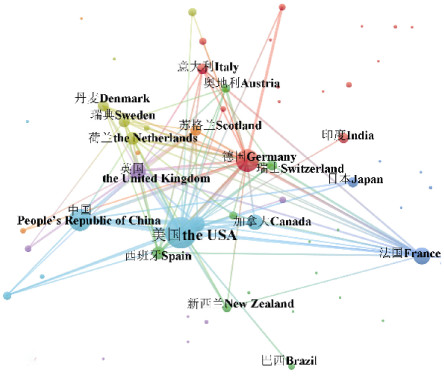
|
图 2 土壤微生物研究领域主要国家间的合作关系 Fig. 2 Cooperations between major countries in the field of soil microbiology |
表 1列举了发文量前10的研究机构,中国科学院的发文量和被引总频次均处于首位,发文量为位于第二位的法国农业科学研究院的2.48倍,图 3揭示其年度发文数量快速增加,年度被引总频次也呈指数增长形势,但篇均被引频次较低。其他研究机构发文量无明显变化,处于平稳增减状态。重要研究机构间的合作关系如图 4,中国科学院与中国农业科学院、浙江大学、清华大学、美国农业部农业研究组织、哥廷根大学等研究机构存在合作,中国科学院处于合作网络图谱的中心位置,同国内研究机构的合作关系较为密切。
|
|
表 1 土壤微生物文献发表量前10名的研究机构 Table 1 The top 20 research institutions in literature contribution in the field of soil microorganisms |
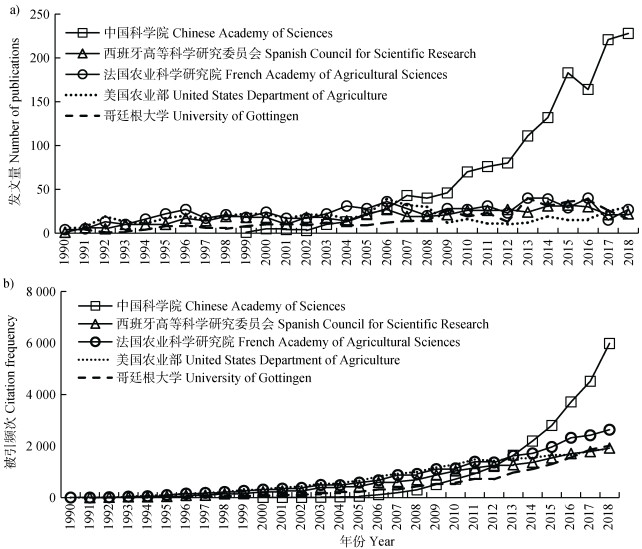
|
注:a)为总发文量前5的研究机构的年度发文量变化;b)为总发文量前5的研究机构的年度被引总频次变化趋势。 Note:a)Change in annual publication of the top 5 research institutions in total number of publications; b)Change in total citation frequency of the top 5 research institutions in total number of publications. 图 3 主要研究机构的发文量和被引频次的年度变化情况 Fig. 3 Annual changes in publication and citation frequency relative to research institution |
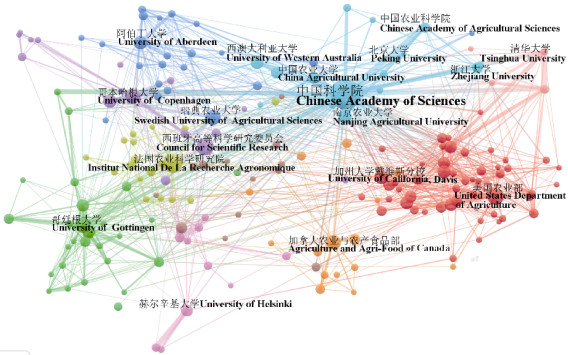
|
图 4 土壤微生物研究领域重要研究机构间的合作关系 Fig. 4 Cooperations between important research institutions in the field of soil microbiology |
表 2统计了国际土壤微生物相关研究主要的发文期刊。发文量最高的是期刊Soil Biology & Biochemistry,占总发文量的19.5%。期刊Applied and Environmental Microbiology发文量低于Soil Biology & Biochemistry 的50%,但是被引用总频次紧逼Soil Biology & Biochemistry,篇均被引用频次位于首位。期刊New Phytologist、Global Change Biology、ISME Journal虽然发文数量较低,但是论文被引用频次高,文章影响力较大。期刊Soil Science Society of America Journal期刊影响因子较低,发文量不高,但论文的被引总频次高,篇均被引频次位于前列。在关注影响因子较高期刊的同时,科研人员对综合影响力高的期刊上的论文也应加以关注,全面地了解土壤微生物领域的发文动态。
|
|
表 2 土壤微生物文献发文总量前20名的期刊 Table 2 Top 20 journals in literature contribution in the field of soil microorganisms |
通过对高被引文章的追踪分析,了解该文章对后面研究的影响程度,进而掌握关于土壤微生物研究的重点与热点。从表 3中的第一作者国家分析来看,美国7篇,占半数以上,证明其在土壤微生物研究领域的较高国际影响力。2000年后发表的高被引论文有5篇,其中被引总频次第一的就是Schloss和Handelsman[15]在2005年发表的关于用软件DOTUR对测得的基因序列划分独立操作单元(OTU),估算生物丰富度和多样性指数。期刊Applied and Environmental Microbiology上的高被引文章有6篇,高质量论文较多。其中有6篇高被引文章是关于分子生物学技术,如聚合酶链式反应(PCR)、末端限制性片段长度多态性(T-RFLP)分析技术、磷脂脂肪酸(PLFA)、焦磷酸测序应用到土壤微生物学研究中,推动了土壤微生物学的发展。由图 5可知,Kozich等[16]的论文于2013发表后,其年度被引总频次呈快速增长,论文影响力大,可见新一代测序技术对土壤微生物学的发展有重要影响。
|
|
表 3 土壤微生物研究领域被引总次数前10名的文章 Table 3 Top 10 highly cited articles in the field of soil microorganism |
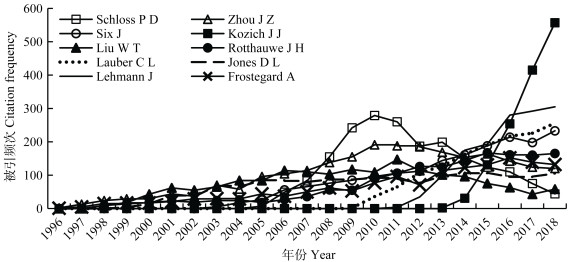
|
图 5 高被引论文的年度被引总频次变化情况 Fig. 5 Change in annual total citation frequency of the highly- cited papers |
将1990—2018年国外发表的土壤微生物的论文分为3个时间段:1990—2000年、2001—2010年、2011—2018年。利用CiteSpace构建不同时期关键词共现网络图谱,分析图谱结果。图 6中节点的年轮结构表示的是该文献被引用的历史,节点的半径越大说明该节点的总被引频次越高,有紫色外圈的节点是具有高中介中心性的节点,这些节点的中心度不小于0.1。1990—2000年中“细菌Bacteria”和“微生物生物量Microbial biomass”的出现频次较高,“微生物生物量”的中心度为0.3,是关键词网络中的重要连接点。“氮Nitrogen”、“氮矿化N mineralization”、“硝化过程Nitrification”、“反硝化过程Denitrification”“分解Decomposition”、“有机质Organic matter”、“碳Carbon”形成聚类,反映土壤微生物研究主要是土壤碳氮养分转化和有机质降解过程[17-18]。“生长Growth”、“植物Plant”、“小麦Wheat”、“生物防治Biocontrol”、“根际Rhizosphere”相关联,表明关注土壤微生物对植物的防病促生作用的研究[19-20]。1990—2000年对于特定土壤微生物纯菌株的研究是本阶段的特色,如与固氮过程相关的根瘤菌,以及参与植物根部氮磷吸收的丛枝菌根真菌、囊泡丛枝菌根等[21-23]。随着PCR等分子生物学技术应用到土壤微生物研究中,对于根际微生物过程的研究不断细化深入,其包含的重要关键词数量增多。2001—2010年关键词网络更加密集,高中介中心度、高频词的节点明显增多,不同研究热点间形成较多交叉。“微生物生物量”出现频次不断增加,同时“微生物群落Microbial community”和“多样性Diversity”增长为主要的高频关键词,关键词“微生物群落”、“PCR”、“基因Gene”、“DGGE”、“DNA”、“PLFA”聚集出现,说明分子生物学技术应用到土壤微生物群落与多样性研究方面。图 6a)中“细菌”、“根际”、“碳”、“氮”、“有机质”、“分解”依然是重要节点,它们的出现频次均大幅上升。“碳”、“氮”、“氮矿化”出现显著紫色外圈且与其他关键节点的交叉越来越丰富,本阶段研究土壤微生物间的养分循环调控机制,对于提高土壤肥力和养分有效性有重要作用[24-25]。“根际”、“植物”、“生长”、“菌根真菌AM”、“磷Phosphorus”等相互联系,揭示了土壤微生物在磷循环和植物有效性中扮演重要角色[26],并且以根际为核心的土壤微生物研究进一步加强[27]。图 6b)中“污染土壤Polluted soil”、“重金属Heavy metal”、“生物修复Bioremediation”组成一个研究热点,微生物降解对于污染土壤的修复备受关注[28-29]。2011—2018年,国外土壤微生物研究领域的发文量稳步增加,形成的关键词网络成熟度高,各个重要节点联系紧密。“多样性”成为出现频次最高的节点,“碳”、“有机质”、“微生物生物量”中心度突出,深入探究土壤微生物在养分循环转化中的作用机理[30-31]。图 6c )中“微生物群落”、“生态系统Ecosystem”、“生物多样性Biodiversity”相联系,表明科研人员更加关注陆地生态系统中土壤微生物群落组成,土壤微生物多样性对于生态环境变化的响应[32]。在微生物与生物地球化学过程中,微生物群落或者个体对于气候变化的响应机制研究也是重要研究内容[33]。“多样性”、“微生物群落”、“根际”、“植物”相互连接,对于根际的研究更加关注微生物对植物生长及养分吸收的作用机理方向[34]。
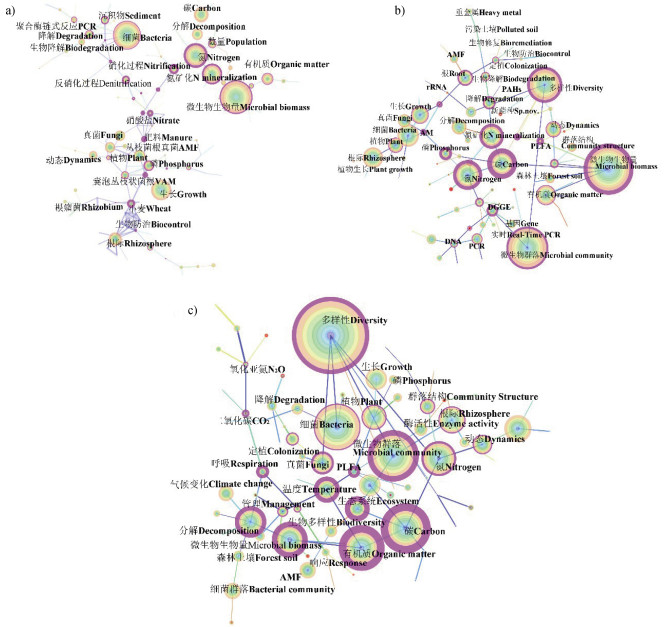
|
注:AMF:丛枝菌根真菌;VAM:囊泡丛枝状菌根;PAHs:多环芳烃;rRNA:核糖体RNA;AM:丛枝菌根;PLFA:磷脂脂肪酸;DGGE:变性梯度凝胶电泳;DNA:脱氧核糖核酸;PCR:聚合酶链式反应。下同。 Note:AMF:Arbuscular mycorrhizal fungi; VAM:Vesicular-arbuscular mycorrhiza; PAHs:Polycyclic aromatic hydrocarbons; rRNA:Ribosomal RNA; AM:Arbuscular mycorrhiza; PLFA:Phospholipid fatty acid; DGGE:Denatured gradient gel electrophoresis; DNA:DeoxyriboNucleic acid; PCR:Polymerase chain reaction. The same below. 图 6 国外学者发表的土壤微生物研究领域文献的关键词共现网络图谱 Fig. 6 Keyword co-occurring network atlas of the literature contributed by foreign researchers in the field of soil microorganism |
为得到国内土壤微生物领域研究热点的演变过程,将1990—2018年发表的论文划分为3个时间段:1990—2000年、2001—2010年、2011—2018年。针对不同时间段进行关键词共现分析,构建网络图谱。1990—2000年国内发表论文数量少,研究内容分散,关键词出现频率低,交互联系少,难以形成关键词共现网络。图 7a)中“微生物生物量”、“多样性”、“细菌”、“根际”、“动态”、“碳”、“氮”、“有机质”是出现频率较高节点。2001—2010年国内土壤微生物研究处于缓慢发展阶段,单个节点较多,但也出现一些相关联的节点。“氮”、“碳”、“氮矿化”、“硝化过程”、“有机质”、“分解”、“动态”关键词聚集,说明国内学者主要关注土壤微生物对有机质转化,碳氮养分循环的作用[35-36]。随着实时PCR、变性梯度凝胶电泳DGGE、磷脂脂肪酸PLFA等分子生物学技术方面关键词的增加,增强了对微生物生物量、微生物群落结构和多样性的研究[37-38]。图 7a)中出现了“细菌群落Bacterial community”、“森林土壤Forest soil”、“AMF”等红色的突发性节点,说明相关研究主题的活跃性。2011—2018年国内土壤微生物发文量增长迅速,不同研究热点间的聚集和联系更加丰富。“多样性”和“微生物群落”的出现频次突出,同时“多样性”与其他节点连线较多。土壤微生物多样性与碳氮转化、有机质降解是研究热点,“氨氧化细菌AOB”、“硝化”、“反硝化”相连接,探究氨氧化微生物在土壤硝化过程中所起作用[39-40]。“AMF”、“定殖Colonization”、“根际”和“磷”相连接,表明研究更加关注菌根真菌与植物的相互作用方式[41]以及菌根真菌提高植物吸收磷的作用机制[42]。“生物修复”、“降解Degradation”、“重金属”、“污染土壤”聚集在一起且出现频次不断提高,污染土壤及其生物降解修复机制成为研究热点。图 7b)中“草原Grassland”、“呼吸Respiration”、“气候变化Climate change”、“CO2升高Elevated CO2”、“微生物生物量”相互连接,探究气候变化对土壤微生物多样性和结构功能的影响[43-44],说明土壤微生物对全球环境变化的响应机制是该时期的一个研究主题。

|
注:AOB:氨氧化细菌;AOA:氨氧化古菌。 Note:AOB:Ammonia oxidizing bacteria; AOA:Ammonia oxidizing archaea. 图 7 国内学者发表的土壤微生物研究领域文献的关键词共现网络图谱 Fig. 7 Keyword co-occurring network atlas of the literature contributed by domestic researchers in the field of soil microorganisms |
本文基于文献计量学的可视化方法分析了1990—2018年的土壤微生物研究领域的文献数据,发现国际土壤微生物领域的总发文量呈增加趋势,各国间合作密切。中国的年发文量在2010年后大幅增加,但论文被引频次低于美国和德国。美国在土壤微生物学领域具有很大的国际影响力,引领该领域的研究发展方向。中国科学院的发文量和总被引频次均居于首位,且与国内外重要研究机构的合作不断加强。此外,Applied and Environmental Microbiology、Soil Biology & Biochemistry、ISME Journal等均是土壤微生物领域的重要期刊。由关键词网络分析可知,国际上土壤微生物研究在土壤养分循环、全球环境变化和污染土壤修复等方面取得重大进展。中国土壤微生物学的研究网络形成稍晚,但发展迅速,研究内容逐渐与国际研究方向保持一致。其中土壤微生物的群落组成、多样性和功能的时空演变规律、驱动机制是土壤微生物学的主要研究方向之一。同时应加强土壤养分转化的微生物驱动机制,地上植物与地下微生物相互作用的研究,有助于提升土壤肥力,提高养分利用率,更好地服务于农业生产;加强土壤微生物与全球变化的研究,深入研究温室气体产生和氧化的微生物机理及其对全球变化的响应;土壤微生物-植物的联合修复技术是土壤污染修复领域的重要途径;增强对关键微生物类群的研究,微生物类群间的正反馈作用机制,定量研究微生物功能群的作用。
| [1] |
Jansson J K, Prosser J I. The life beneath our feet[J]. Nature, 2013, 494(7435): 40-41. DOI:10.1038/494040a
(  0) 0) |
| [2] |
Wang S, Fu B J, Gao G Y, et al. Responses of soil moisture in different land cover types to rainfall events in a re-vegetation catchment area of the Loess Plateau, China[J]. Catena, 2013, 101: 122-128. DOI:10.1016/j.catena.2012.10.006
(  0) 0) |
| [3] |
Chen G, Zhu H L, Zhang Y. Soil microbial activities and carbon and nitrogen fixation[J]. Research in Microbiology, 2003, 154(6): 393-398. DOI:10.1016/S0923-2508(03)00082-2
(  0) 0) |
| [4] |
Diacono M, Montemurro F. Long-term effects of organic amendments on soil fertility. A review[J]. Agronomy for Sustainable Development, 2010, 30(2): 401-422. DOI:10.1051/agro/2009040
(  0) 0) |
| [5] |
van der Heijden M G A, Bardgett R D, van Straalen N M. The unseen majority: Soil microbes as drivers of plant diversity and productivity in terrestrial ecosystems[J]. Ecology Letters, 2008, 11(3): 296-310.
(  0) 0) |
| [6] |
Shen R F, Zhao X Q. Role of soil microbes in the acquisition of nutrients by plants (In Chinese)[J]. Acta Ecologica Sinica, 2015, 35(20): 6584-6591. [沈仁芳, 赵学强. 土壤微生物在植物获得养分中的作用[J]. 生态学报, 2015, 35(20): 6584-6591.]
(  0) 0) |
| [7] |
Li L L, Ding G H, Feng N, et al. Global stem cell research trend : Bibliometric analysis as a tool for mapping of trends from 1991 to 2006[J]. Scientometrics, 2009, 80(1): 39-58. DOI:10.1007/s11192-008-1939-5
(  0) 0) |
| [8] |
Zhang S, Mao G Z, Crittenden J, et al. Groundwater remediation from the past to the future: A bibliometric analysis[J]. Water Research, 2017, 119: 114-125. DOI:10.1016/j.watres.2017.01.029
(  0) 0) |
| [9] |
Mao G Z, Shi T T, Zhang S, et al. Bibliometric analysis of insights into soil remediation[J]. Journal of Soils and Sediments, 2018, 18(7): 2520-2534. DOI:10.1007/s11368-018-1932-4
(  0) 0) |
| [10] |
Song C Q, Tan W F. The historical venation of soil science in the past 30 years-based on the bibliometric analysis (In Chinese)[J]. Acta Pedologica Sinica, 2015, 52(5): 957-969. [宋长青, 谭文峰. 基于文献计量分析的近30年国内外土壤科学发展过程解析[J]. 土壤学报, 2015, 52(5): 957-969.]
(  0) 0) |
| [11] |
Kamdem J P, Duarte A E, Lima K R R, et al. Research trends in food chemistry: A bibliometric review of its 40 years anniversary(1976-2016)[J]. Food Chemistry, 2019, 294: 448-457. DOI:10.1016/j.foodchem.2019.05.021
(  0) 0) |
| [12] |
Sun B, Wang X Y, Lü X H. The historical venation in research on microbial mechanisms of soil nutrient cycling in the past 60 years-Based on bibliometric analysis and big data visualization (In Chinese)[J]. Journal of Plant Nutrition and Fertilizer, 2017, 23(6): 1590-1601. [孙波, 王晓玥, 吕新华. 我国60年来土壤养分循环微生物机制的研究历程--基于文献计量学和大数据可视化分析[J]. 植物营养与肥料学报, 2017, 23(6): 1590-1601.]
(  0) 0) |
| [13] |
Zheng M S, Fu H Z, Ho Y S. Research trends and hotspots related to ammonia oxidation based on bibliometric analysis[J]. Environmental Science and Pollution Research, 2017, 24(25): 20409-20421. DOI:10.1007/s11356-017-9711-0
(  0) 0) |
| [14] |
Chen Y, Chen C M, Hu Z G. Principles and applications of analyzing a citation space (In Chinese). Beijing: Science Press, 2014: 46. [陈悦, 陈超美, 胡志刚. 引文空间分析原理与应用[M]. 北京: 科学出版社, 2014: 46.]
(  0) 0) |
| [15] |
Schloss P D, Handelsman J. Introducing DOTUR, a computer program for defining operational taxonomic units and estimating species richness[J]. Applied and Environmental Microbiology, 2005, 71(3): 1501-1506.
(  0) 0) |
| [16] |
Kozich J J, Westcott S L, Baxter N T, et al. Development of a dual-index sequencing strategy and curation pipeline for analyzing amplicon sequence data on the MiSeq illumina sequencing platform[J]. Applied and Environmental Microbiology, 2013, 79(17): 5112-5120.
(  0) 0) |
| [17] |
Wardle D A, Yeates G W, Nicholson K S, et al. Response of soil microbial biomass dynamics, activity and plant litter decomposition to agricultural intensification over a seven-year period[J]. Soil Biology & Biochemistry, 1999, 31(12): 1707-1720.
(  0) 0) |
| [18] |
Attiwill P M, Adams M A. Nutrient cycling in forests[J]. New Phytologist, 1993, 124(4): 561-582.
(  0) 0) |
| [19] |
de Brito A M, Gagne S, Antoun H. Effect of compost on rhizosphere microflora of the tomato and on the incidence of plant growth-promoting rhizobacteria[J]. Applied and Environmental Microbiology, 1995, 61(1): 194-199.
(  0) 0) |
| [20] |
Crawford D L, Lynch J M, Whipps J M, et al. Isolation and characterization of actinomycete antagonists of a fungal root pathogen[J]. Applied and Environmental Microbiology, 1993, 59(11): 3899-3905.
(  0) 0) |
| [21] |
Aarons S R, Graham P H. Response of Rhizobium leguminosarum bv phaseoli to acidity[J]. Plant and Soil, 1991, 134(1): 145-151.
(  0) 0) |
| [22] |
Amewowor D H A K, Madelin M F. Numbers of myxomycetes and associated microorganisms in the root zones of cabbage(Brassica oleracea) and broad bean (Vicia faba) in field plots[J]. FEMS Microbiology Letters, 1991, 86(1): 69-82.
(  0) 0) |
| [23] |
Ahiabor B D, Hirata H. Characteristic responses of 3 tropical legumes to the inoculation of two species of VAM fungi in Andosol soils with different fertilities[J]. Mycorrhiza, 1994, 5(1): 63-70.
(  0) 0) |
| [24] |
Bengtson P, Basiliko N, Prescott C E, et al. Spatial dependency of soil nutrient availability and microbial properties in a mixed forest of Tsuga heterophylla and Pseudotsuga menziesii, in coastal British Columbia, Canada[J]. Soil Biology & Biochemistry, 2007, 39(10): 2429-2435.
(  0) 0) |
| [25] |
Accoe F, Boeckx P, Busschaert J, et al. Gross N transformation rates and net N mineralisation rates related to the C and N contents of soil organic matter fractions in grassland soils of different age[J]. Soil Biology & Biochemistry, 2004, 36(12): 2075-2087.
(  0) 0) |
| [26] |
Achat D L, Bakker M R, Zeller B, et al. Long-term organic phosphorus mineralization in Spodosols under forests and its relation to carbon and nitrogen mineralization[J]. Soil Biology & Biochemistry, 2010, 42(9): 1479-1490.
(  0) 0) |
| [27] |
Kent A D, Triplett E W. Microbial communities and their interactions in soil and rhizosphere ecosystems[J]. Annual Review of Microbiology, 2002, 56(1): 211-236.
(  0) 0) |
| [28] |
De Lourdes Bellinaso M, Greer C W, do Carmo Peralba M, et al. Biodegradation of the herbicide trifluralin by bacteria isolated from soil[J]. FEMS Microbiology Ecology, 2003, 43(2): 191-194.
(  0) 0) |
| [29] |
Abou-Shanab R A I, Angle J S, Chaney R L. Bacterial inoculants affecting nickel uptake by Alyssum murale from low, moderate and high Ni soils[J]. Soil Biology & Biochemistry, 2006, 38(9): 2882-2889.
(  0) 0) |
| [30] |
Baldrian P, Kolařík M, Štursová M, et al. Active and total microbial communities in forest soil are largely different and highly stratified during decomposition[J]. The ISME Journal, 2012, 6(2): 248-258.
(  0) 0) |
| [31] |
Baskaran P, Hyvönen R, Berglund S L, et al. Modelling the influence of ectomycorrhizal decomposition on plant nutrition and soil carbon sequestration in boreal forest ecosystems[J]. New Phytologist, 2017, 213(3): 1452-1465.
(  0) 0) |
| [32] |
Ben-David E A, Zaady E, Sher Y, et al. Assessment of the spatial distribution of soil microbial communities in patchy arid and semi-arid landscapes of the Negev Desert using combined PLFA and DGGE analyses[J]. FEMS Microbiology Ecology, 2011, 76(3): 492-503.
(  0) 0) |
| [33] |
A'Bear A D, Jones T H, Kandeler E, et al. Interactive effects of temperature and soil moisture on fungal-mediated wood decomposition and extracellular enzyme activity[J]. Soil Biology & Biochemistry, 2014, 70: 151-158.
(  0) 0) |
| [34] |
Bowles T M, Jackson L E, Cavagnaro T R. Mycorrhizal fungi enhance plant nutrient acquisition and modulate nitrogen loss with variable water regimes[J]. Global Change Biology, 2018, 24(1): e171-e182.
(  0) 0) |
| [35] |
An S S, Huang Y M, Zheng F L. Evaluation of soil microbial indices along a revegetation chronosequence in grassland soils on the Loess Plateau, Northwest China[J]. Applied Soil Ecology, 2009, 41(3): 286-292.
(  0) 0) |
| [36] |
Deng H, Zhang B, Yin R, et al. Long-term effect of re-vegetation on the microbial community of a severely eroded soil in sub-tropical China[J]. Plant and Soil, 2010, 328(1): 447-458.
(  0) 0) |
| [37] |
Chu H Y, Lin X G, Fujii T, et al. Soil microbial biomass, dehydrogenase activity, bacterial community structure in response to long-term fertilizer management[J]. Soil Biology & Biochemistry, 2007, 39(11): 2971-2976.
(  0) 0) |
| [38] |
Chan O C, Yang X D, Fu Y, et al. 16S rRNA gene analyses of bacterial community structures in the soils of evergreen broad-leaved forests in south-west China[J]. FEMS Microbiology Ecology, 2006, 58(2): 247-259.
(  0) 0) |
| [39] |
Ai C, Liang G Q, Sun J W, et al. Different roles of rhizosphere effect and long-term fertilization in the activity and community structure of ammonia oxidizers in a calcareous fluvo-aquic soil[J]. Soil Biology and Biochemistry, 2013, 57: 30-42.
(  0) 0) |
| [40] |
He J Z, Hu H W, Zhang L M. Current insights into the autotrophic thaumarchaeal ammonia oxidation in acidic soils[J]. Soil Biology & Biochemistry, 2012, 55: 146-154.
(  0) 0) |
| [41] |
Hua J F, Jiang Q, Bai J F, et al. Interactions between arbuscular mycorrhizal fungi and fungivorous nematodes on the growth and arsenic uptake of tobacco in arsenic-contaminated soils[J]. Applied Soil Ecology, 2014, 84: 176-184.
(  0) 0) |
| [42] |
Cao J, Huang Y, Wang C. Rhizosphere interactions between earthworms (Eisenia fetida) and arbuscular mycorrhizal fungus(Funneliformis mosseae) promote utilization efficiency of phytate phosphorus in maize[J]. Applied Soil Ecology, 2015, 94: 30-39.
(  0) 0) |
| [43] |
Hu H W, MacDonald C A, Trivedi P, et al. Effects of climate warming and elevated CO2 on autotrophic nitrification and nitrifiers in dryland ecosystems[J]. Soil Biology & Biochemistry, 2016, 92: 1-15.
(  0) 0) |
| [44] |
Feng W T, Liang J Y, Hale L E, et al. Enhanced decomposition of stable soil organic carbon and microbial catabolic potentials by long-term field warming[J]. Global Change Biology, 2017, 23(11): 4765-4776.
(  0) 0) |
 2020, Vol. 57
2020, Vol. 57


